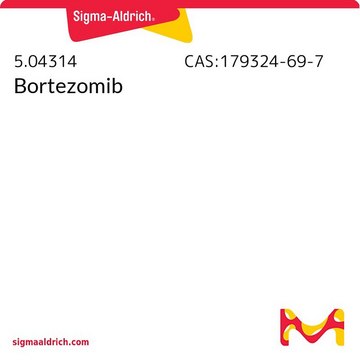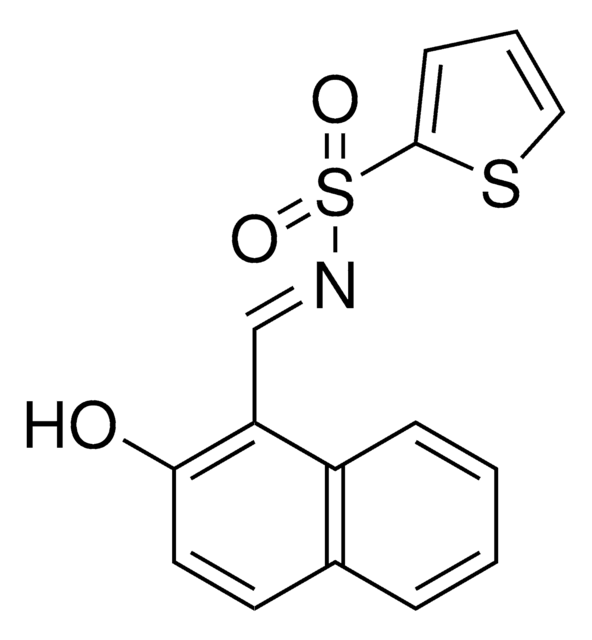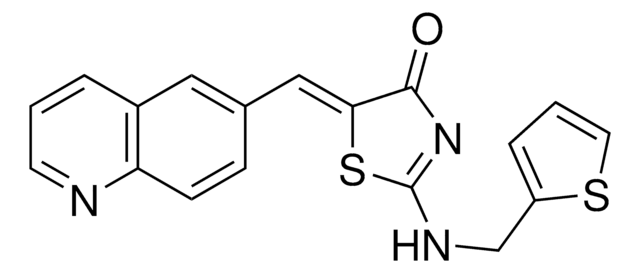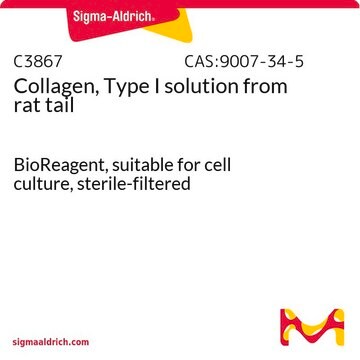412512
IRE1 Inhibitor III, 4μ8C
IRE1 Inhibitor III, CAS 14003-96-4, is a cell-permeable. Covalent inhibitor of IRE1 RNase activity (IC₅₀ = 550 and 45 nM, respectively, with 0 & 16 min preincubation in RNA cleavage assays).
동의어(들):
IRE1 Inhibitor III, 4μ8C, 8-Formyl-7-hydroxy-4-methylcoumarin, 7-Hydroxy-4-methyl-2-oxo-2H-chromene-8-carbaldehyde, ER-to-Nucleus Signaling 1 Inhibitor III, Inositol-Reguiring Protein 1 Inhibitor III
로그인조직 및 계약 가격 보기
모든 사진(2)
About This Item
실험식(Hill 표기법):
C11H8O4
CAS Number:
Molecular Weight:
204.18
MDL number:
UNSPSC 코드:
12352200
NACRES:
NA.28
추천 제품
Quality Level
분석
≥95% (HPLC)
양식
powder
제조업체/상표
Calbiochem®
저장 조건
OK to freeze
protect from light
색상
yellow
solubility
DMSO: 25 mg/mL
배송 상태
ambient
저장 온도
2-8°C
SMILES string
O=C(C=C1C)OC2=C1C=CC(O)=C2C=O
InChI
1S/C11H8O4/c1-6-4-10(14)15-11-7(6)2-3-9(13)8(11)5-12/h2-5,13H,1H3
InChI key
RTHHSXOVIJWFQP-UHFFFAOYSA-N
일반 설명
A cell-permeable coumarin o-hydroxyaldehyde compound that inhibits IRE1 RNase activity in a time- and dose-dependent manner (IC50 = 550, 230, 180, 100, and 45 nM, respectively, with 0, 2, 4, 8, 16, min drug preincubation in FRET-based RNA cleavage assays) by covalently targeting IRE1 Lys907 via Schiff base formation, effectively preventing ER stress-induced site-specific mRNA splicing as well as RIDD (Regulated IRE1-Dependent Degradation) mRNA degradation (IC50 = 6.9 and 4.1 µM, respectively, against Xbp1 splicing and Scara3 degradation) in MEF cultures following Tunicamycin (Cat. No. 654380) treatment. Also demonstrated to inhibit ER capacity expansion (Effective conc. 32 µM) and amylase secretion (IC50<2 µM) upon stress induction by Dexamethasone (Cat. No. 265005) treatment in rat AR42J tumoral acinar pancreatic cells. Structural analysis reveals that the reduced water accessibility to Lys907 in IRE1 native conformation accounts for the unusual stability of Lys907 Schiff base formation and forms the basis of selective IRE1 RNase inhibition by 4μ8C and STF083010 (Cat. No. 412510). Although 4μ8C, but not STF083010, is also shown to inhibit IRE1 autophosphorylation by Schiff base formation with IRE1 Lys599 in the absence of ADP, cellular nucleotide prevents 4μ8C from targeting IRE1 Lys599 and inhibiting IRE1 kinase activity intracellularly.
A cell-permeable coumarin o-hydroxyaldehyde that inhibits IRE1 RNase activity in a time- and dose-dependent manner (IC50 = 550 and 45 nM, respectively, with 0 and 16 min drug preincubation in RNA cleavage assays) by covalently targeting IRE1 Lys907 via Schiff base formation, effectively preventing ER stress-induced site-specific mRNA splicing as well as RIDD (Regulated IRE1-Dependent Degradation) mRNA degradation (IC50 = 6.9 and 4.1 µM, respectively, against Xbp1 splicing and Scara3 degradation) in MEF cultures following Tunicamycin (Cat. No. 654380) treatment. Comparing to STF083010 (Cat. No. 412510), 4μ8C is also shown to inhibit IRE1 autophosphorylation in cell-free assays via Schiff base formation with IRE1 Lys599 in the absence of ADP, however cellular nucleotide prevents 4μ8C from targeting IRE1 Lys599 intracellularly.
생화학적/생리학적 작용
Cell permeable: yes
Primary Target
IRE1
IRE1
Reversible: yes
포장
Packaged under inert gas
경고
Toxicity: Standard Handling (A)
재구성
Following reconstitution, aliquot and freeze (-20°C). Stock solutions are stable for up to 6 months.
기타 정보
Cross, B.C.S., et al. 2012. Proc. Natl. acad. Sci. USA109, E869.
법적 정보
CALBIOCHEM is a registered trademark of Merck KGaA, Darmstadt, Germany
Storage Class Code
11 - Combustible Solids
WGK
WGK 3
Flash Point (°F)
Not applicable
Flash Point (°C)
Not applicable
시험 성적서(COA)
제품의 로트/배치 번호를 입력하여 시험 성적서(COA)을 검색하십시오. 로트 및 배치 번호는 제품 라벨에 있는 ‘로트’ 또는 ‘배치’라는 용어 뒤에서 찾을 수 있습니다.
이미 열람한 고객
Aparajita Madhavan et al.
Nature communications, 13(1), 608-608 (2022-02-03)
In obesity, signaling through the IRE1 arm of the unfolded protein response exerts both protective and harmful effects. Overexpression of the IRE1-regulated transcription factor XBP1s in liver or fat protects against obesity-linked metabolic deterioration. However, hyperactivation of IRE1 engages regulated IRE1-dependent
Rohit B Sharma et al.
The Journal of biological chemistry, 295(41), 14164-14177 (2020-08-14)
Success or failure of pancreatic beta cell adaptation to ER stress is a determinant of diabetes susceptibility. The ATF6 and IRE1/XBP1 pathways are separate ER stress-response effectors important to beta cell health and function. ATF6α. and XBP1 direct overlapping transcriptional
Rachel E Carlisle et al.
Cell death & disease, 12(10), 921-921 (2021-10-10)
Chronic kidney disease (CKD) is characterized by the gradual loss of renal function and is a major public health concern. Risk factors for CKD include hypertension and proteinuria, both of which are associated with endoplasmic reticulum (ER) stress. ER stress-induced
José P Guirao-Abad et al.
mSphere, 5(5) (2020-10-23)
The unfolded protein response (UPR) is a signaling network that maintains homeostasis of the endoplasmic reticulum (ER). In the human-pathogenic fungus Aspergillus fumigatus, the UPR is initiated by activation of an endoribonuclease (RNase) domain in the ER transmembrane stress sensor
Michael J Grey et al.
The Journal of clinical investigation, 132(17) (2022-06-22)
Epithelial cells lining mucosal surfaces of the gastrointestinal and respiratory tracts uniquely express ERN2/IRE1β, a paralogue of the most evolutionarily conserved endoplasmic reticulum stress sensor, ERN1/IRE1α. How ERN2 functions at the host-environment interface and why a second paralogue evolved remain
자사의 과학자팀은 생명 과학, 재료 과학, 화학 합성, 크로마토그래피, 분석 및 기타 많은 영역을 포함한 모든 과학 분야에 경험이 있습니다..
고객지원팀으로 연락바랍니다.






![PERK Inhibitor I, GSK2606414 GSK2606414 is a cell-permeable, highly potent inhibitor of EIF2AK3/PERK (IC₅₀ = 0.4 nM; [ATP] = 5 µM). Targets PERK in its inactive DFG conformation at the ATP-binding region.](/deepweb/assets/sigmaaldrich/product/structures/180/559/efa716dc-d5fe-4339-a6f0-0103084fc04a/640/efa716dc-d5fe-4339-a6f0-0103084fc04a.png)




